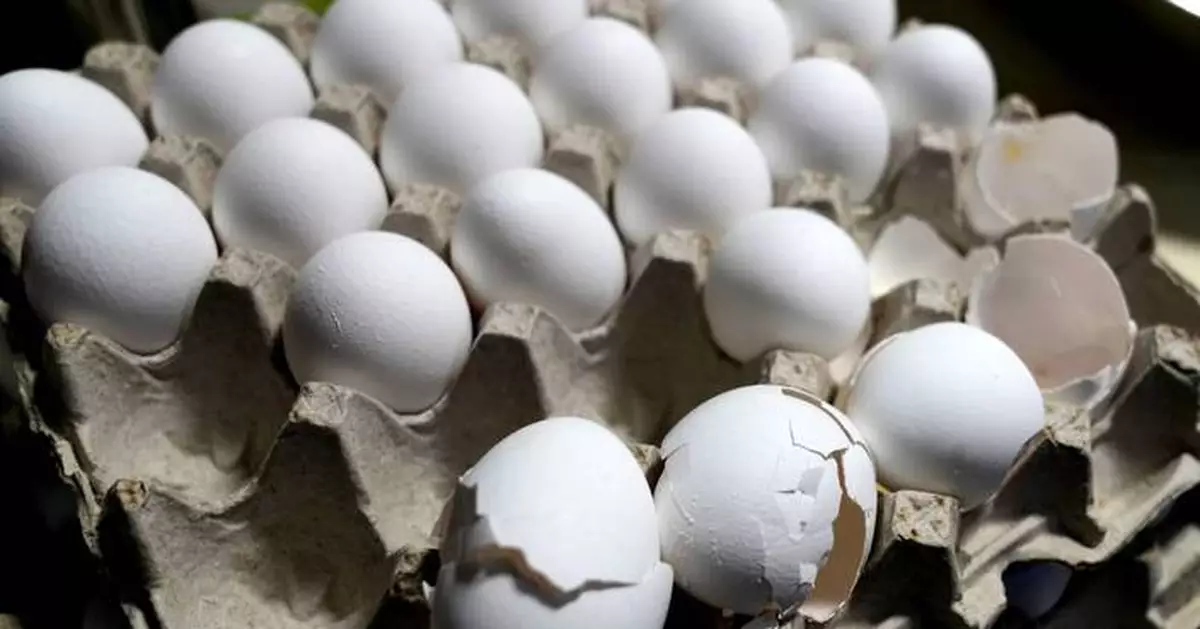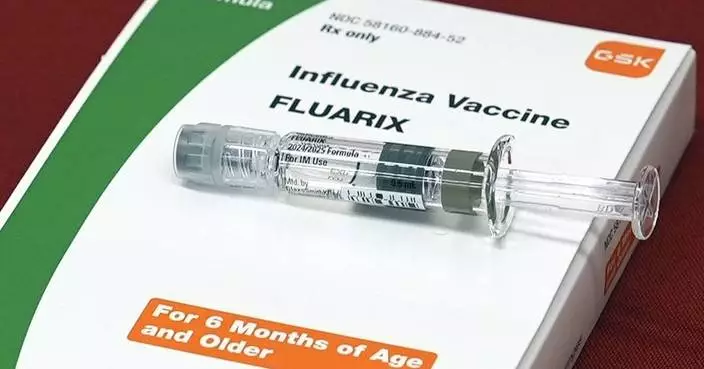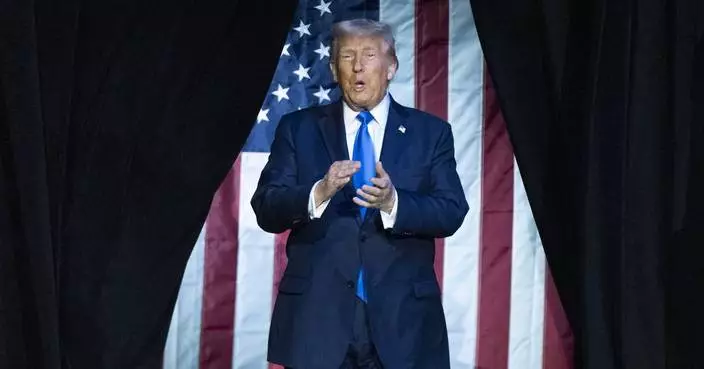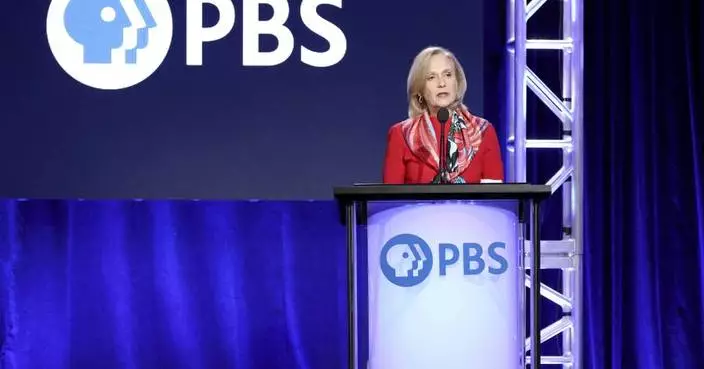U.S. egg prices increased again last month to reach a new record-high of $6.23 per dozen despite President Donald Trump’s predictions, a drop in wholesale prices and no egg farms having bird flu outbreaks.
The increase reported Thursday in the Consumer Price Index means consumers and businesses that rely on eggs might not get much immediate relief. Demand for eggs is typically elevated until after Easter, which falls on April 20.
Click to Gallery
Eggs are displayed in a grocery store in Carmel, Ind., Wednesday, April 9, 2025. (AP Photo/Michael Conroy)
Eggs are displayed in a grocery store in Carmel, Ind., Wednesday, April 9, 2025. (AP Photo/Michael Conroy)
Eggs are displayed in a grocery store in Carmel, Ind., Wednesday, April 9, 2025. (AP Photo/Michael Conroy)
Eggs are displayed in a grocery store in Carmel, Ind., Wednesday, April 9, 2025. (AP Photo/Michael Conroy)
Eggs are displayed in a grocery store in Carmel, Ind., Wednesday, April 9, 2025. (AP Photo/Michael Conroy)
FILE - Cartons of eggs sit on a shelf in a Walmart store, March 10, 2025, in Englewood, Colo. (AP Photo/David Zalubowski, File)
Eggs are displayed in a grocery store in Carmel, Ind., Wednesday, April 9, 2025. (AP Photo/Michael Conroy)
FILE - A carton of eggs sit on a counter in the kitchen inside of 5 Rabanitos restaurant in Chicago, Feb. 16, 2025. (AP Photo/Nam Y. Huh, File)
Industry experts were expecting the index to reflect a drop in retail egg prices because wholesale egg prices fell significantly in March. University of Arkansas agricultural economist Jada Thompson said the wholesale prices did not start dropping until mid-March, so there may not have been enough time for the average price for the month to decline. And grocery stores may not have immediately passed on the lower prices.
Bird flu outbreaks were cited as the major cause of price spikes in January and February after more than 30 million egg-laying chickens were killed to prevent the spread of the disease. Only 2.1 million birds were slaughtered in March and none of them were on egg farms.
Egg prices hit $5.90 in February one month after setting a record at $4.95 per dozen, according to the U.S. Bureau of Labor Statistics.
The farms that had fall outbreaks have been working to resume egg production after sanitizing their barns and raising new flocks, but chickens must be about six months old before they start laying eggs. Thompson said those farms did not come back online as quickly as anticipated.
In the latest U.S. Department of Agriculture numbers, there were only about 285 million hens laying eggs nationwide as of March 1, Before the outbreak, the flock typically numbered more than 315 million.
Since the current bird flu outbreak began, more than 168 million birds have been slaughtered, most of them egg-laying chickens. Any time a bird gets sick, the entire flock is killed to help keep bird flu from spreading. That can have an effect on the egg supply because massive egg farms may have millions of birds.
Trump tried to take credit for the lower wholesale egg prices the USDA reported in recent weeks.
“The egg prices they were going through the sky. And you did a fantastic job,” Trump said to Agriculture Secretary Brooke Rollins before he announced the details of his tariffs at the White House last week. ”Now we have lots of eggs and they are much cheaper now.”
But experts say the president’s plan to fight bird flu by focusing on strengthening egg farmers’ defenses against the virus is likely to be more of a long-term help.
The Agriculture Department tried to find egg imports to add to the supply and nearly 4 million dozens of eggs were brought into the country in February. But egg traders saw an opportunity with the high prices and 7.6 million dozens were exported. Numbers for March were not yet available.
“I think there are lots of people who are looking to see the egg prices coming down because they wanted to call it a win. And I think it’s a loss for everybody. I think we all want to see egg prices come down,” Thompson said.
Rollins on Thursday suggested the rise in egg prices is temporary. She pointed to the overall consumer price index showing a slight dip in prices for goods and services across the U.S. economy in March and suggested egg prices will soon follow.
“We’re also moving into the Super Bowl of eggs, which is Easter,” Rollins said. “So from the beginning, I’ve said this is sort of the high price for retail for eggs, but we feel very confident that will continue to come back down.”
Earlier this week, Trump said the annual White House egg roll would use real eggs again this year despite the high prices. Egg farmers typically donate more than 30,000 eggs for the event.
U.S. egg prices did began falling in mid-March, according to Datasembly, a market research company that tracks prices at thousands of stores. Datasembly said eggs averaged $5.98 per dozen the week beginning March 16 and dropped to $5.51 the week beginning March 30.
But prices vary widely around the country, depending on the location of recent bird flu outbreaks and some state laws requiring eggs to be cage-free. At a Walmart in Richmond, California, a dozen eggs were $6.34 on Thursday. In Omaha, Nebraska, Walmart was selling eggs for $4.97 per dozen. California requires eggs sold to be cage-free; Nebraska doesn't.
The latest numbers could increase scrutiny of Cal-Maine Foods, which provides 20% of the nation’s eggs, and other large egg producers.
Earlier this week, Cal-Maine acknowledged it is being investigated by the antitrust division of the U.S. Department of Justice, which is looking into egg price increases. Cal-Maine said it is cooperating with the investigation.
In its most recent quarter, which ended March 1, Cal-Maine said its net income more than tripled to $508.5 million compared to the same period a year ago.
The price of real eggs has some consumers turning to fake ones for Easter crafts this year.
Craft retailer Michaels said sales of its plastic egg craft kits — which were listed for $2.49 on the company's website Thursday — are up 20% over last year. Michaels said sales usually peak closer to Easter, but it started seeing a noticeable uptick in early March this year.
“With a little over a week still to go until Easter, our craft egg kits are nearly sold out,” the company said.
Associated Press writer Aamer Madhani contributed to this report.
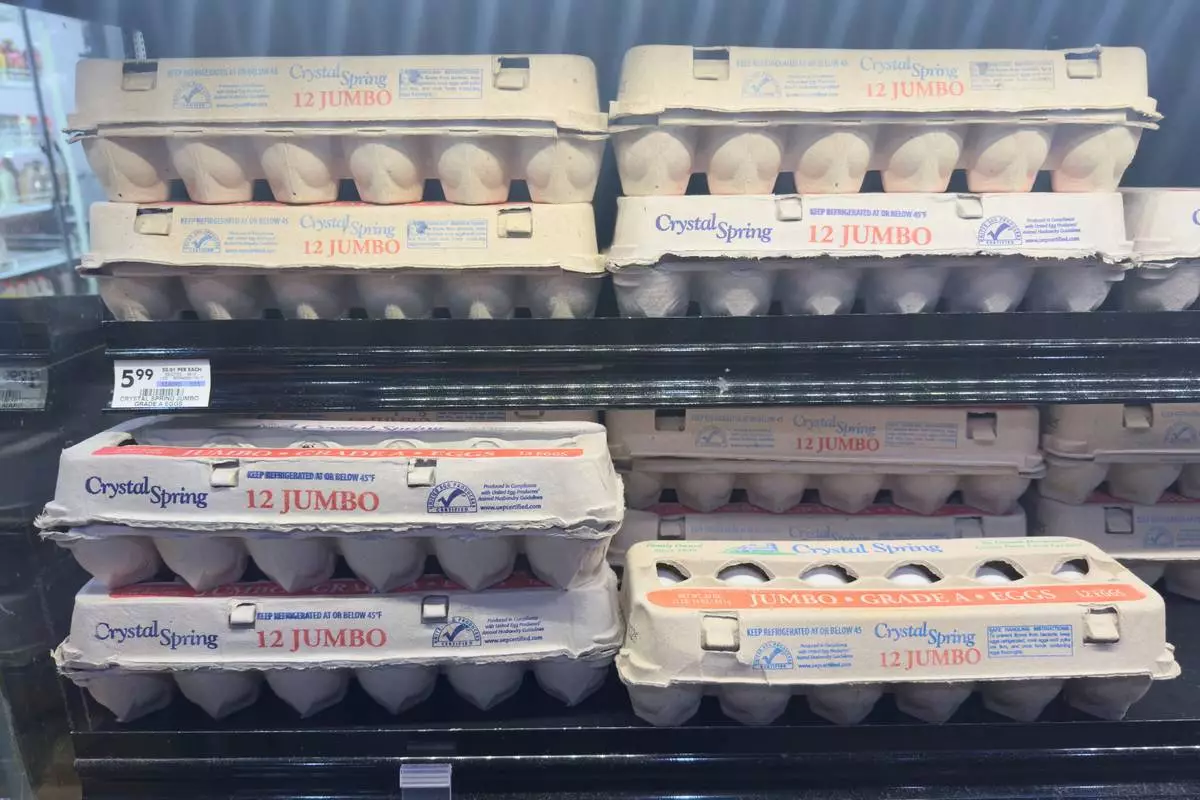
Eggs are displayed in a grocery store in Carmel, Ind., Wednesday, April 9, 2025. (AP Photo/Michael Conroy)

Eggs are displayed in a grocery store in Carmel, Ind., Wednesday, April 9, 2025. (AP Photo/Michael Conroy)

Eggs are displayed in a grocery store in Carmel, Ind., Wednesday, April 9, 2025. (AP Photo/Michael Conroy)
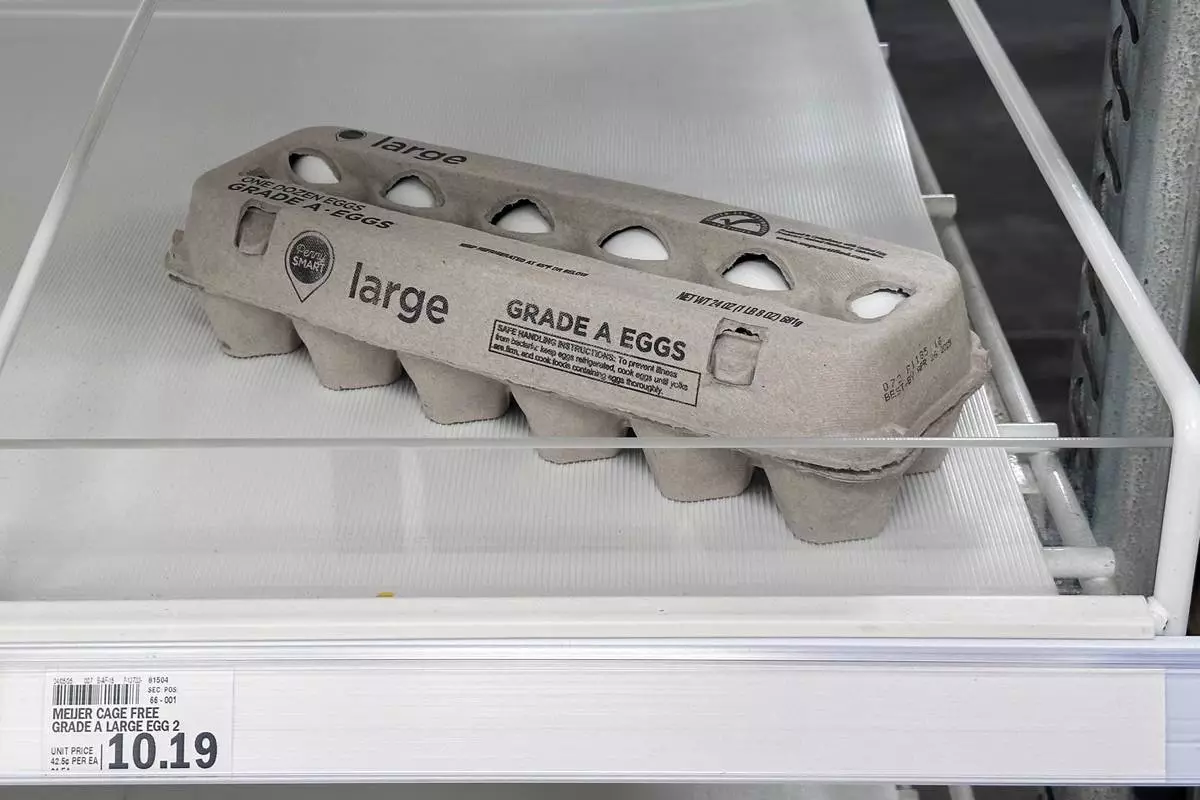
Eggs are displayed in a grocery store in Carmel, Ind., Wednesday, April 9, 2025. (AP Photo/Michael Conroy)

Eggs are displayed in a grocery store in Carmel, Ind., Wednesday, April 9, 2025. (AP Photo/Michael Conroy)
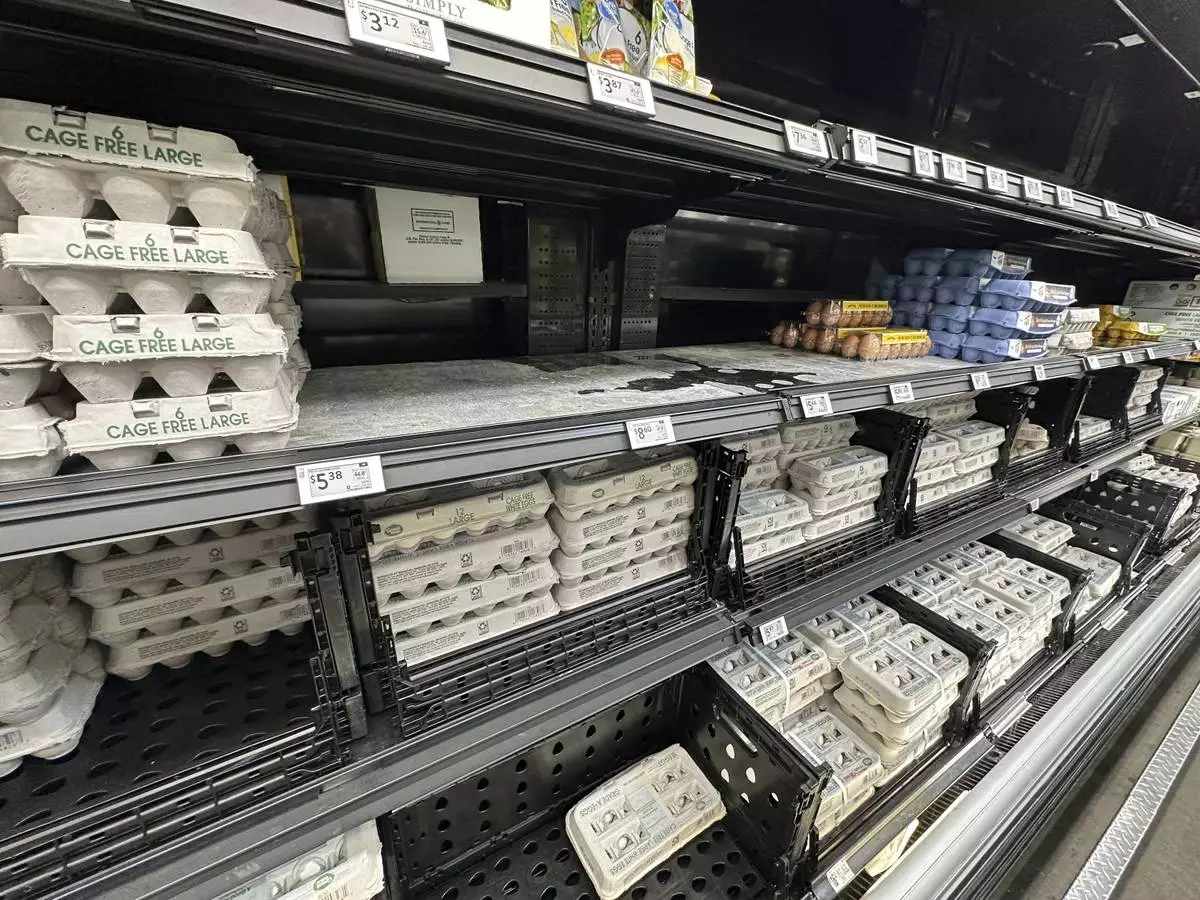
FILE - Cartons of eggs sit on a shelf in a Walmart store, March 10, 2025, in Englewood, Colo. (AP Photo/David Zalubowski, File)
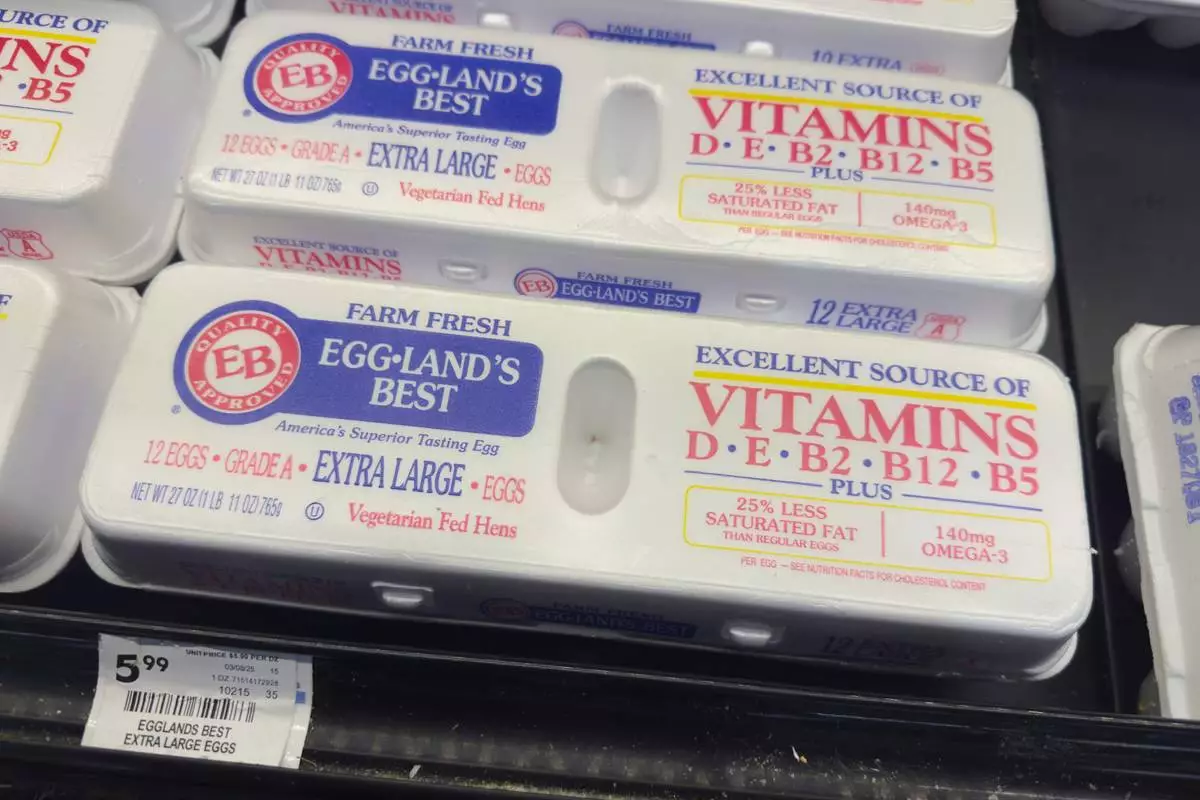
Eggs are displayed in a grocery store in Carmel, Ind., Wednesday, April 9, 2025. (AP Photo/Michael Conroy)
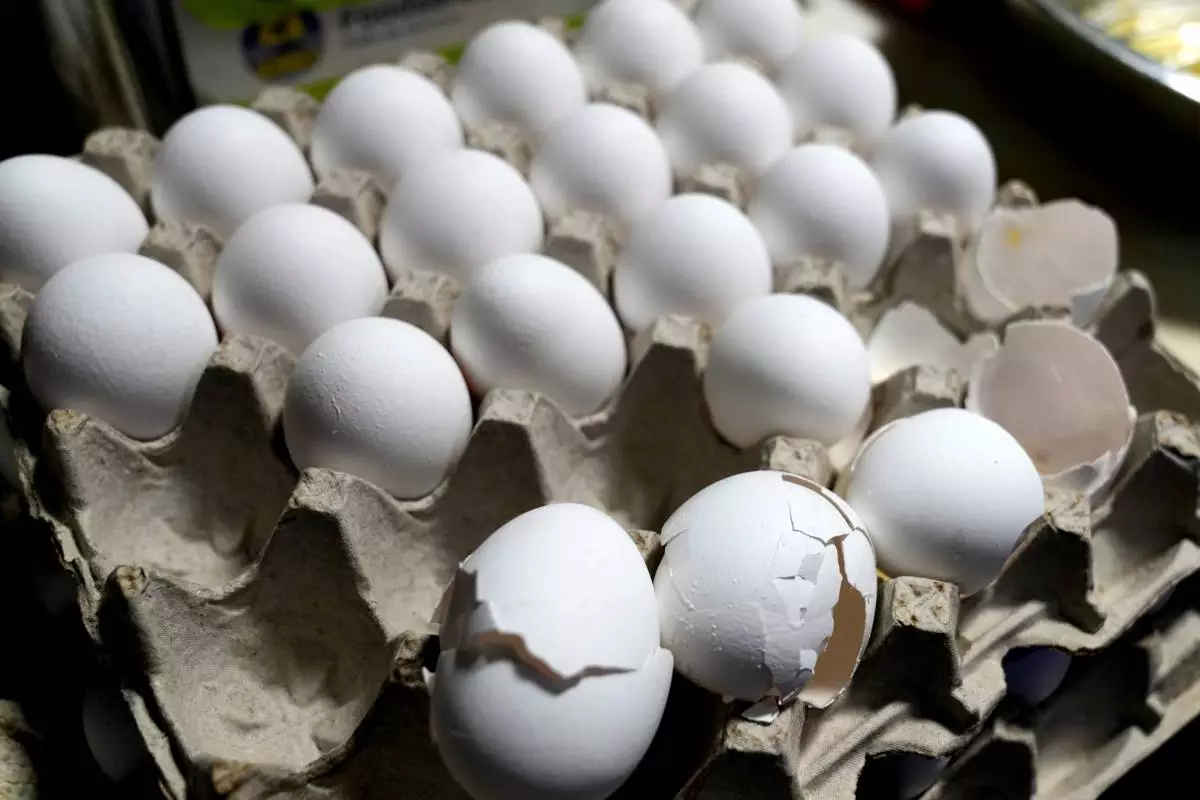
FILE - A carton of eggs sit on a counter in the kitchen inside of 5 Rabanitos restaurant in Chicago, Feb. 16, 2025. (AP Photo/Nam Y. Huh, File)
WASHINGTON (AP) — President Donald Trump's 2026 budget plan would slash non-defense domestic spending by $163 billion while increasing expenditures on national security, according to White House statements Friday.
The plan shows a desire to crack down on diversity programs and initiatives to address climate change. But it doesn't include details about what Trump wants on income taxes, tariffs, entitlement programs or the budget deficit — a sign of the challenge confronting the president when he's promising to cut taxes and repay the federal debt without doing major damage to economic growth.
Budgets do not become law but serve as a touchstone for the upcoming fiscal year debates. Often considered a statement of values, this first budget since Trump's return to the White House carries the added weight of defining the Republican president's second-term pursuits, alongside his party in Congress.
House Speaker Mike Johnson, R-La., said the plan showed fiscal discipline given the problems of persistently high budget deficits. The budget released on Friday did not, in fact, include a forecast on government borrowing.
“President Trump’s plan ensures every federal taxpayer dollar spent is used to serve the American people, not a bloated bureaucracy or partisan pet projects,” Johnson said.
Sen. Patty Murray, D-Wash., said the cuts could ultimately be more extreme than what the administration has proposed, noting that the budget doesn't provide funding levels for programs such as Head Start.
“President Trump has made his priorities clear as day: he wants to outright defund programs that help working Americans while he shovels massive tax breaks at billionaires like himself and raises taxes on middle-class Americans with his reckless tariffs," Murray said.
The budget seeks to cut discretionary spending by a total of 7.6% next year, but includes a 13% increase in national security spending.
The State Department and international programs would lose 84% of their money and receive $9.6 billion, a cut that reflects the existing efforts by adviser Elon Musk’s Department of Government Efficiency.
The Housing and Urban Development Department would get a $33.6 billion cut, while the Health and Human Service Department would receive $33.3 trillion less and the Education Department's spending would be reduced by $12 billion.
The Defense Department would get an additional $113.3 billion and Homeland Security would receive $42.3 billion more.
The IRS and FBI would lose money, while the Low Income Home Energy Assistance Program would be ended. There would be $980 million less for college students in work-study programs, as well as similarly sized cuts for adult education and instruction for learning English.
The Centers for Disease Control and Prevention would lose nearly $3.6 billion under the plan, while the National Institutes of Health would face a steep cut of almost $18 billion. The budget would eliminate more than $15 billion for infrastructure-related programs tied to climate change and $1.3 billion from the National Oceanic and Atmospheric Administration.
The White House budget plan arrives as Trump has unilaterally imposed what could hundreds of billions of dollars in tax increases in the form of tariffs, setting off a trade war that has consumers, CEOs and foreign leaders worried about a possible economic downturn.
The White House's Office of Management and Budget, headed by Russell Vought, a chief architect of Project 2025, provided contours of a so-called skinny version of topline numbers only regarding discretionary spending. Administration officials said a fuller budget will come soon with plans to address the drivers of the annual deficit.
The nation's estimated $7 trillion-plus federal budget has been growing steadily, with annual deficits fast approaching $2 trillion and the annual interest payments on the debt almost $1 trillion. That's thanks mostly to the spike in emergency COVID-19 pandemic spending, changes in the tax code that reduced revenues and the climbing costs of Medicare, Medicaid and other programs, largely to cover the nation's health needs as people age. The nation's debt load, at $36 trillion, is ballooning.
Democrats are prepared to assail Trump's budget as further evidence that the Republican administration is intent on gutting government programs that Americans depend on.
Congress is already deep into the slog of drafting of Trump's big bill of tax breaks, spending cuts and bolstered funds for the administration's mass deportation effort — a package that, unlike the budget plan, would carry the force of law.
But deep differences remain among the Republicans, who are trying to pass that big bill over the objections of Democrats.
"We are awaiting some final calculations on a few of the tax components, and we expect to be able to complete that work on a very aggressive schedule,” Johnson said.
It's Congress, under its constitutional powers, that decides the spending plans, approves the bills that authorize federal programs and funds them through the appropriations process. Often, that system breaks down, forcing lawmakers to pass stopgap spending bills to keep the government funded and avoid federal shutdowns.
Vought is also expected on Capitol Hill in the weeks ahead as the Trump administration presses its case to Congress for funds.
Among the more skilled conservative budget hands in Washington, Vought has charted a career toward this moment. He served during the first Trump administration in the same role and, for Project 2025, wrote an extensive chapter about the remaking of the federal government.
Vought has separately been preparing a $9 billion package that would gut current 2025 funding for the U.S. Agency for International Development and the Corporation for Public Broadcasting, which involves the Public Broadcasting Service and National Public Radio. Trump signed an executive order late Thursday that instructs the Corporation for Public Broadcasting and federal agencies to cease funding for PBS and NPR.
Vought has said that package of so-called budget rescissions would be a first of potentially more, as the Trump administration tests the appetite in Congress for lawmakers to go on record and vote to roll back the money.
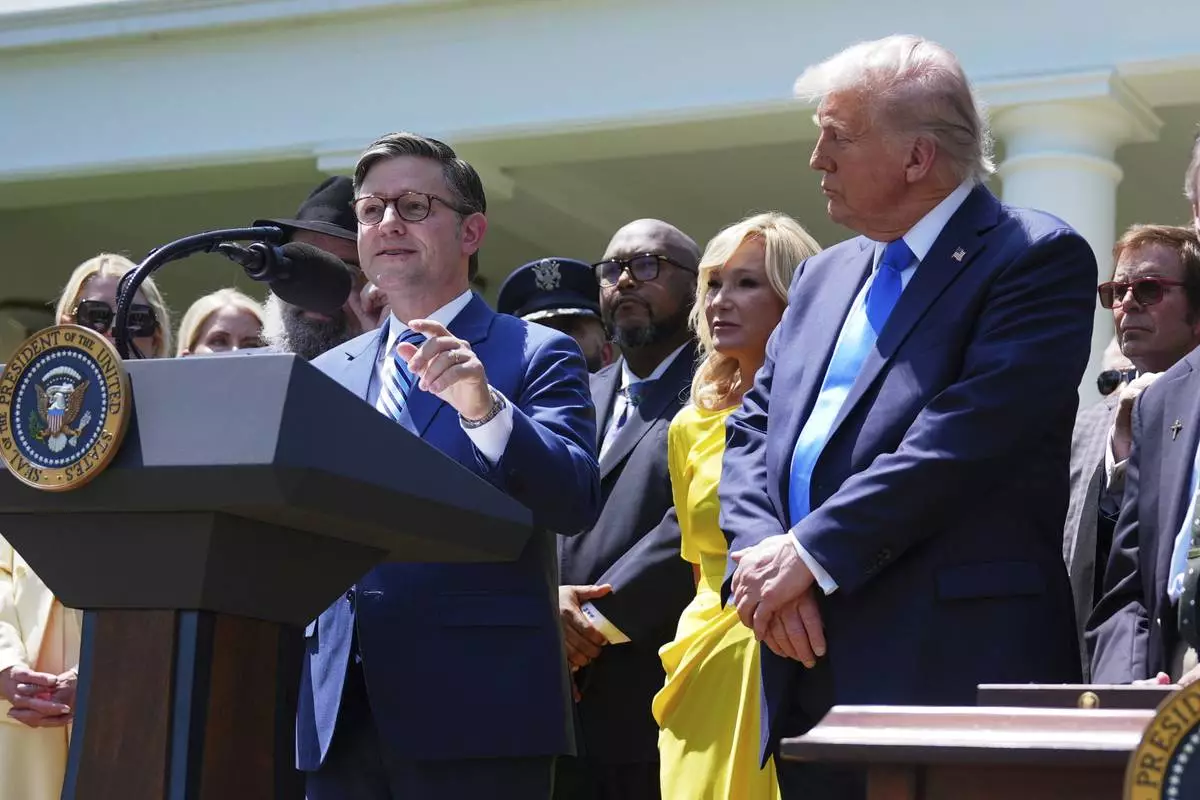
House Speaker Mike Johnson, R-La., speaks as President Donald Trump, right, listens during a National Day of Prayer event in the Rose Garden of the White House, Thursday, May 1, 2025, in Washington. (AP Photo/Evan Vucci)
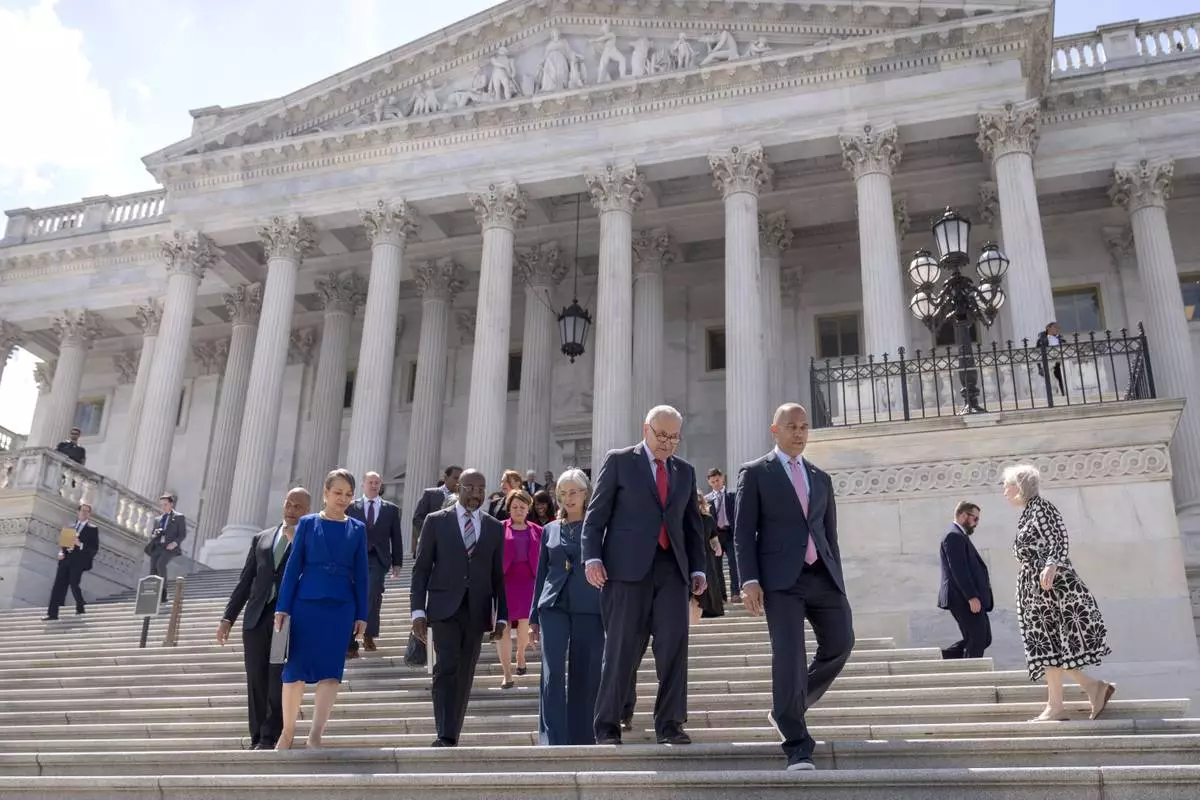
Senate Minority Leader Chuck Schumer, of N.Y., second from right, and House Minority Leader Hakeem Jeffries, of N.Y., right, arrive with other House and Senate Democrats for an event to mark 100 days of President Donald Trump's term on the steps of the Senate on Capitol Hill, Wednesday, April 30, 2025, in Washington. (AP Photo/Mark Schiefelbein)
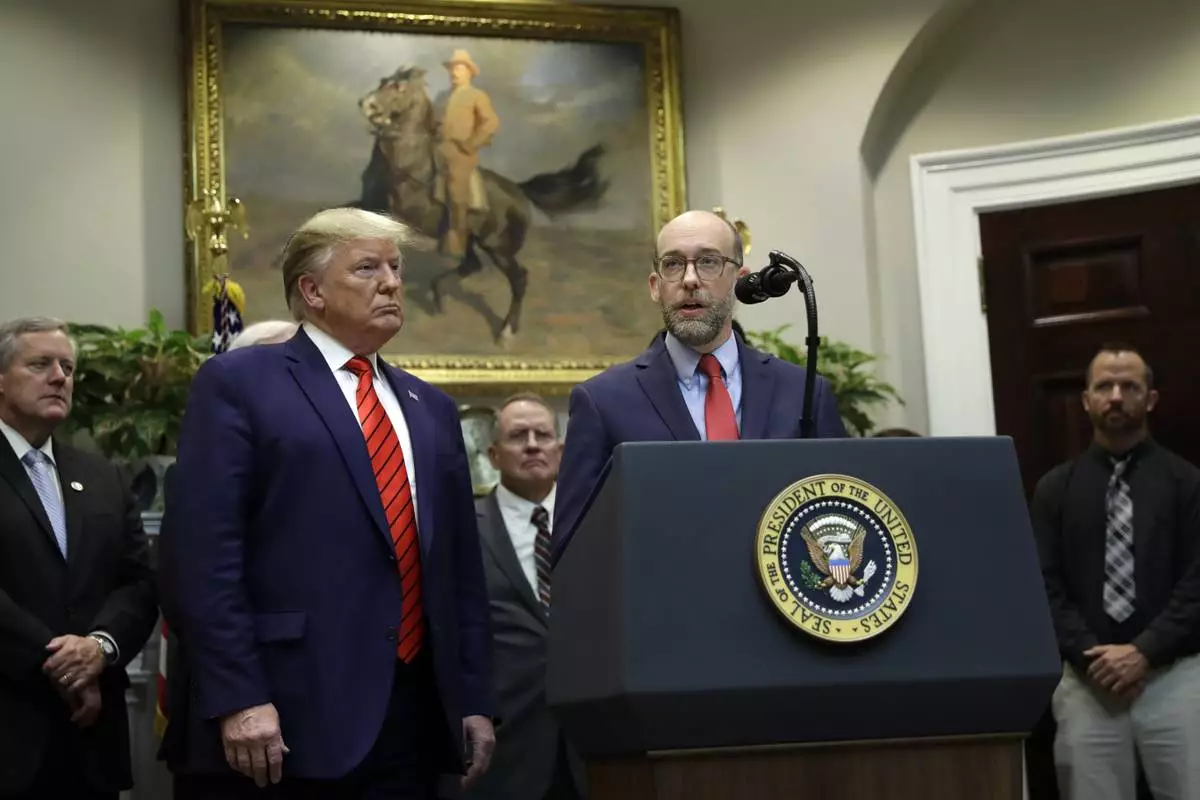
FILE - President Donald Trump listens as acting director of the Office of Management and Budget Russ Vought speaks during an event on "transparency in Federal guidance and enforcement" in the Roosevelt Room of the White House, Oct. 9, 2019, in Washington. (AP Photo/Evan Vucci, File)










